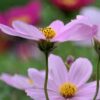**Cosmos Flowers: Opportunities for Environmental Education and Nature Conservation**

Cosmos flowers, with their vibrant blooms and ecological significance, present valuable opportunities for environmental education and nature conservation initiatives. As symbols of beauty and biodiversity, cosmos flowers serve as powerful teaching tools for fostering a deeper understanding of ecosystems, promoting environmental stewardship, and inspiring action to protect natural habitats. In this comprehensive exploration, we delve into the diverse opportunities for utilizing cosmos flowers in environmental education programs and initiatives aimed at conserving and preserving the natural world.
**1. Botanical Gardens and Arboreta:**
Botanical gardens and arboreta play a vital role in environmental education by showcasing diverse plant collections, including cosmos flowers, in immersive and interactive settings. Educational programs and guided tours at botanical institutions provide visitors with opportunities to learn about the ecological importance of cosmos flowers, their pollinator relationships, and their role in supporting biodiversity. Hands-on activities such as seed planting, flower dissections, and garden maintenance workshops engage visitors of all ages in learning about plant biology and conservation practices.
**2. School Gardens and Outdoor Classrooms:**
School gardens and outdoor classrooms offer students hands-on learning experiences with cosmos flowers, fostering connections to nature and promoting environmental literacy. Curriculum-based activities centered around cosmos gardens provide opportunities for students to explore topics such as plant life cycles, pollination ecology, and sustainable gardening practices. Through planting, observing, and caring for cosmos flowers, students develop a deeper appreciation for the natural world and gain valuable skills in critical thinking, problem-solving, and environmental stewardship.
**3. Community Engagement and Citizen Science:**
Cosmos flowers engage communities in citizen science initiatives and community-based conservation projects that contribute to scientific research and monitoring efforts. Citizen scientists can participate in programs such as flower counts, phenology observations, and pollinator surveys to collect data on cosmos populations and their interactions with other species. By engaging in citizen science, individuals of all ages and backgrounds become active participants in conservation efforts, contributing valuable data that informs management decisions and conservation strategies.
**4. Nature Reserves and Wildlife Sanctuaries:**
Nature reserves and wildlife sanctuaries provide protected habitats for cosmos flowers and other native flora and fauna, serving as living laboratories for environmental education and nature conservation. Guided tours, interpretive trails, and educational signage at nature reserves offer visitors opportunities to learn about the ecological significance of cosmos flowers, their adaptations to local environments, and their role in supporting wildlife habitat. By visiting and supporting nature reserves, individuals contribute to the preservation of natural ecosystems and the protection of cosmos flowers for future generations to enjoy.
**5. Environmental Workshops and Outreach Programs:**
Environmental workshops and outreach programs raise awareness about the importance of cosmos flowers and native plant conservation through interactive learning experiences and community engagement activities. Workshops on topics such as pollinator gardening, habitat restoration, and invasive species management empower participants to take action to protect cosmos flowers and promote biodiversity in their own communities. Outreach programs in schools, libraries, and community centers provide educational resources, such as lesson plans, fact sheets, and educational videos, that inspire individuals to become advocates for nature conservation.
**6. Sustainable Agriculture and Urban Gardening:**
Cosmos flowers inspire sustainable agriculture practices and urban gardening initiatives that promote biodiversity, food security, and ecosystem resilience. Community gardens, rooftop farms, and urban green spaces featuring cosmos plantings provide opportunities for residents to learn about sustainable gardening techniques, composting, and water conservation. By incorporating cosmos flowers into urban landscapes, cities and communities create vibrant green spaces that support pollinators, enhance biodiversity, and improve the quality of urban environments.
**7. Cultural and Indigenous Perspectives:**
Cosmos flowers hold cultural significance in many indigenous cultures, where they are revered as symbols of beauty, resilience, and connection to the land. Cultural exchange programs and indigenous-led initiatives incorporate traditional knowledge and practices related to cosmos flowers into environmental education and conservation efforts. By honoring indigenous perspectives and traditional ecological knowledge, we enrich our understanding of cosmos flowers and their importance in cultural heritage preservation and sustainable stewardship of natural resources.
**8. Conclusion:**
In conclusion, cosmos flowers offer myriad opportunities for environmental education and nature conservation initiatives that empower individuals and communities to become stewards of the natural world. By harnessing the beauty and ecological significance of cosmos flowers, we can inspire future generations to appreciate, protect, and conserve the rich diversity of plant life and ecosystems on our planet. Through collaborative efforts and collective action, we can ensure the continued survival and resilience of cosmos flowers and their habitats for generations to come.

